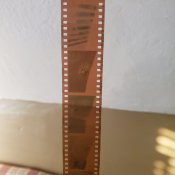So I have an SRT 101 that needs a good remedial CLA. Mainly it has mirror problems.
At slow speeds sometimes the mirror doesn't come down after exposure, which is really not that much of a problem since recocking the shutter brings it down.
There's a weird problem, though. On a lot of frames, I see the mirror coming down early. But that's not the weird part.
Picture of negative strip attached below. As you can see, this is a classic mirror fault. The weird part is, I cannot see the problem on any speed when looking through the back of the shutter. I see the entire film gate clearly.
The fault only seems to happen when there's film in the camera, and it seems to happen in the last half of the roll and happen consistently after a certain point.
What in God's name is going on with this camera?
At slow speeds sometimes the mirror doesn't come down after exposure, which is really not that much of a problem since recocking the shutter brings it down.
There's a weird problem, though. On a lot of frames, I see the mirror coming down early. But that's not the weird part.
Picture of negative strip attached below. As you can see, this is a classic mirror fault. The weird part is, I cannot see the problem on any speed when looking through the back of the shutter. I see the entire film gate clearly.
The fault only seems to happen when there's film in the camera, and it seems to happen in the last half of the roll and happen consistently after a certain point.
What in God's name is going on with this camera?











